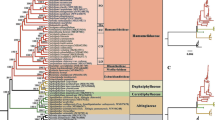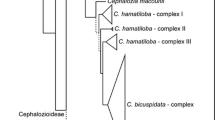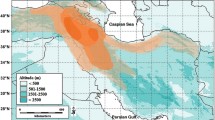Abstract
Parsimony and maximum likelihood analyses of combinedtrnL (UAA) 5′ exon —trnF (GAA) andrps4 exon cpDNA, and 18S nrDNA sequences of 60 arthrodontous moss taxa indicate strong support for the monophyly of a clade containing theSplachnineae, Orthotrichineae, and diplolepideous alternate sub-orders. A clade including theSplachnineae, Meesiaceae andLeptobryum (Bryaceae) is similarly well supported and forms the sister group to a clade comprising theOrthotrichineae and the other diplolepideous alternate mosses. Within this latter clade a number of well supported lineages are identified, but relationships among these remain poorly resolved. These analyses indicate that the Splachnaceous and Orthotrichaceous peristomes have been independently derived from an ancestral ‘perfect’ bryoid peristome.
Similar content being viewed by others
References
Allsop, A., Mitra, G. C., 1958: The morphology of protonema and bud formation in theBryales. — Ann. Bot.22: 95–115.
Blomquist, H. L., Robertson, L. L., 1941: The development of the peristome inAulacomnium heterostichum. — Bull. Torrey Bot. Club68: 569–584.
Bremer, K., 1988: The limits of amino acid sequence data in angiosperm phylogenetic reconstruction. — Evolution42: 795–803.
Brotherus, V. F., 1924:Musci III. UnterklasseBryales, spezieller Teil. — InEngler, A., Prantl, K., (Eds): Die natürlichen Pflanzenfamilien.10.Musci (Laubmoose) 1. Hälfte, pp. 132–478. — Leipzig: Engelmann.
Buck, W. R., 1980: A generic revision of theEntodontaceae. — J. Hattori Bot. Lab.48: 71–159.
, 1986: Suggestion for a new familial classification of pleurocarpous mosses. — Taxon35: 21–60.
Crum, H. A., Anderson, L. E., 1981: Mosses of Eastern North America. — New York: Columbia University Press.
De Luna, E., 1995: The circumscription and phylogenetic relationships of theHedwigiaceae (Musci). — Syst. Bot.20: 347–373.
Dixon, H. N., 1932: Classification of mosses. — InVerdoon, F., (Ed.): Manual of bryology, pp. 397–412. — The Hague: Martius Nijhoff.
Donoghue, M. J., Sanderson, M. J., 1992: The suitability of molecular and morphological evidence in reconstructing plant phylogeny. — InSoltis, P. S., Soltis, D. E., Doyle, J. J., (Eds): Molecular systematics of plants, pp. 340–368. — London: Chapman & Hall.
Edwards, S. R., 1979: Taxonomic implications of cell patterns on haplolepideous moss peristomes. — InClarke, G. C. S., Duckett, J. G., (Eds): Bryophyte systematics. Syst. Assoc. Special Vol.14, pp. 317–346. — New York: Academic Press.
, 1984: Homologies and inter-relations of moss peristomes. — InSchuster, R. M., (Ed.): New manual of bryology, pp. 658–695. — Nichinan: Hattori Botanical Laboratory.
Edwards, K., Johnstone, C., Thompson, C., 1991: A simple and rapid method for the preparation of plant genomic DNA for PCR analysis. — Nucl. Acids Res.19: 1349.
Erikkson, T., Wikström, N., 1995: AutoDecay: programme and documentation.
Farris, J. S., Albert, V. A., Källersjö, M., Lipscomb, D., Kluge, A. G., 1996: Parsimony Jackknifing outperforms neighbor-joining. — Cladistics12: 99–124.
Felsenstein, J. S., 1978: Cases in which parsimony and compatibility will be positively misleading. — Syst. Zool.27: 401–410.
Givnish, T. J., Sytsma, K. J., 1997: Consistency, characters, and the likelihood of correct phylogenetic inference. — Molec. Phylogenet. Evol.7: 320–330.
Gould, S. J., 1977: Ontogeny and phylogeny. — Cambridge: Harvard University Press.
Hedderson, T. A. J., Cox, C. J., Gibbings, G., 1998a: Phylogenetic relationships of theWardiaceae (Musci); evidence from 18s rRNA and rps4 gene sequences. — Bryologist (in press).
- -Goffinet, B., Chapman, R. L., Waters, D., Vitt, D. H., 1998b: — Phylogenetic relationships among the major lineages of mosses (Bryopsida) inferred from nuclear-encoded small-subunit rRNA gene sequences. — Bryologist (in press).
Hedenäs, L., 1994: The basal pleurocarpous diplolepideous mosses — a cladistic approach. — Bryologist97: 225–243.
Huelsenbeck, J. P., 1991: Tree length distribution skewness: an indicator of phylogenetic information. — Syst. Zool.40: 257–270.
Ireland, R., 1971: Moss pseudoparaphyllia. — Bryologist74: 312–30.
Jukes, T. H., Cantor, C. R., 1969: Evolution of protein molecules. — InMunro, H. N., (Ed.): Mammalian protein metabolism, pp. 21–123. — New York: Academic Press.
Kishino, H., Hasegawa, M., 1989: Evaluation of the maximum likelihood estimate of the evolutionary tree topologies from DNA sequence data, and the branching order inHominoidea. — J. Molec. Evol.29: 170–179.
Koponen, A., 1994:Splachnales. — InSharp, A. J., Crum, H., Eckel, P. M., (Eds): The moss flora of Mexico,1, pp. 444–452. — Bronx, New York: The New York Botanic Garden.
Koponen, T., 1988: The phylogeny and classification of theMniaceae andRhizogoniaceae (Musci). — J. Hattori Bot. Lab.64: 37–46.
La Farge-England, C., 1996: Growth form, branching pattern and perichaetial position in mosses: cladocarpy and pleurocarpy redefined. — Bryologist99: 170–186.
Lewinsky, J., 1989: Does the Orthotrichaceous peristome exist? A study of peristome evolution in the genusOrthotrichum Hedw. with a possible derivation of the haplolepideous peristome. — J. Hattori Bot. Lab.67: 335–363.
Maddison, W. P., Maddison, D. R., 1992: MacClade: analysis of phylogeny and character evolution. Version 3.0. — Sunderland, Massachusetts: Sinauer.
Mishler, B. D., 1986: Ontogeny and phylogeny inTortula (Musci: Pottiaceae). — Syst. Bot.11: 189–208.
, 1984: A cladistic approach to the phylogeny of “bryophytes”. — Brittonia36: 406–424.
, 1991: The use of ontogenetic data in the phylogenetic analysis of mosses. — Advances Bryol.4: 121–167.
-Donoghue, M. J., Albert, V. A., 1991: The decay index as a measure of relative robustness within a cladogram. — In: Willi Hennig Society Meeting, Toronto, Ontario, Abstracts.
, 1992: A molecular approach to the phylogeny of bryophytes: Cladistic analysis of chloroplast encoded 16S and 23S ribosomal RNA genes. — Bryologist95: 172–180.
Nadot, S., Bittar, G., Carter, L., Lacroix, R., Lejeune, B., 1995: A phylogenetic analysis of monocotyledons based on the chloroplast generps4, using parsimony and a new numerical phenetics method. — Molec. Phylogenet. Evol.4: 257–282.
Norris, D. H., Koponen, T., 1996: Bryophyte flora of the Huon Peninsula, Papua New Ginea. LVIII.Hypnodendron (Hypnodendraceae, Musci). — Acta Bot. Fenn.156: 23–48.
Nyholm, E., 1954: Moss Flora of Fennoscandia.2.Musci. — Lund: Gleerup.
Philibert, H., 1884a, b: De l'importance du péristome pour les affinités naturelles des mousses. — Rev. Bryol.11: 49–52, 65–72.
Saito, S., 1956: Studies on the development of the peristome inMusci II. On the peristome inDicranum japonicum Mitt. — Bot. Mag. (Tokyo)69: 53–58.
, 1954: Studies on the development of the peristome inMusci I. On the peristome inBartramia crispata Schimp. — Bot. Mag. (Tokyo)68: 55–60. [In Japanese, English Summary.]
Schwartz, O. M., 1994: The development of the peristome-forming layers in theFunariaceae. — Int. J. Pl. Sci.155: 640–657.
Shaw, J., 1984: Character analysis, phylogeny, and classification of the moss genusPohlia. — Canad. J. Bot.62: 219–229.
, 1985a: The correlation between peristome structure and taxonomy in theBryaceae. — J. Hattori Bot. Lab.59: 79–100.
, 1985b: Endostomal ornamentation in theBryales. — J. Hattori Bot. Lab.59: 303–324.
, 1986: Peristome structure in theOrthotrichaceae. — J. Hattori Bot. Lab.60: 119–136.
, 1988: Peristome development in mosses in relation to systematics and evolution. II.Tetraphis pellucida (Tetraphidaceae). — Amer. J. Bot.75: 1019–1032.
, 1984: Endostomal architecture in diplolepideous mosses. — J. Hattori Bot. Lab.57: 41–67.
, 1989a: Peristome development in mosses in relation to systematics and evolution. III.Funaria hygrometrica, Bryum pseudocapillare, andB. bicolar. — Syst. Bot.14: 24–36.
, 1989b: Peristome development in relation to systematics and evolution. I.Diphyscium foliosum (Buxbaumiaceae). — Mem. New York Bot. Gard.45: 55–70.
Sibley, C. G., Ahlquist, J. E., 1987: Avian phylogeny reconstructed from comparisons of the genetic material, DNA. — InPatterson, C., (Ed.): Molecules and morphology in evolution: conflict or compromise?, pp. 95–121. — Cambridge: Cambridge University Press.
Stone, I. G., 1961: The gametophore and sporophyte ofMittenia plumula (Mitt.)Lindb. — Austral. J. Bot.9: 124–151.
Taberlet, P., Gielley, L., Pautou, G., Bouvet, J., 1991: Universal primers for the amplification of three non-coding regions of chloroplast DNA. — Pl. Molec. Biol.17: 1105–1109.
Taylor, E. C., 1962: The Philibert peristome articles. An abridged translation. — Bryologist65: 175–212.
Touw, A., 1971: A taxonomic revision of theHypnodendraceae (Musci). — Blumea19: 212–354.
Vitt, D. H., 1982:Sphagnopsida andBryopsida. — InParker, S. P., (Ed.): Synopsis and classification of living organisms, pp. 307–336. — New York: McGraw-Hill.
, 1984: Classification of theBryopsida. — InSchuster, R. M., (Ed.): New manual of bryology, pp. 696–759. — Nichinan: Hattori Botanical Laboratory.
, 1998: The ordinal classification of mosses: Questions and answers for the 1990's. — InAshton, N. W., Bates, J. W., Duckett, J. G., (Eds): Bryology for the twenty-first century, pp. 113–124. — Leeds: Maney.
Yang, Z., 1994a: Estimating the pattern of nucleotide substitution. — J. Molec. Evol.39: 105–111.
, 1994b: Maximum likelihood phylogenetic estimation from DNA sequences with variable rates over sites: approximate methods. — J. Molec. Evol.39: 306–314.
Author information
Authors and Affiliations
Rights and permissions
About this article
Cite this article
Cox, C.J., Hedderson, T.A.J. Phylogenetic relationships among the ciliate arthrodontous mosses: Evidence from chloroplast and nuclear DNA sequences. Pl Syst Evol 215, 119–139 (1999). https://doi.org/10.1007/BF00984651
Received:
Accepted:
Issue Date:
DOI: https://doi.org/10.1007/BF00984651




